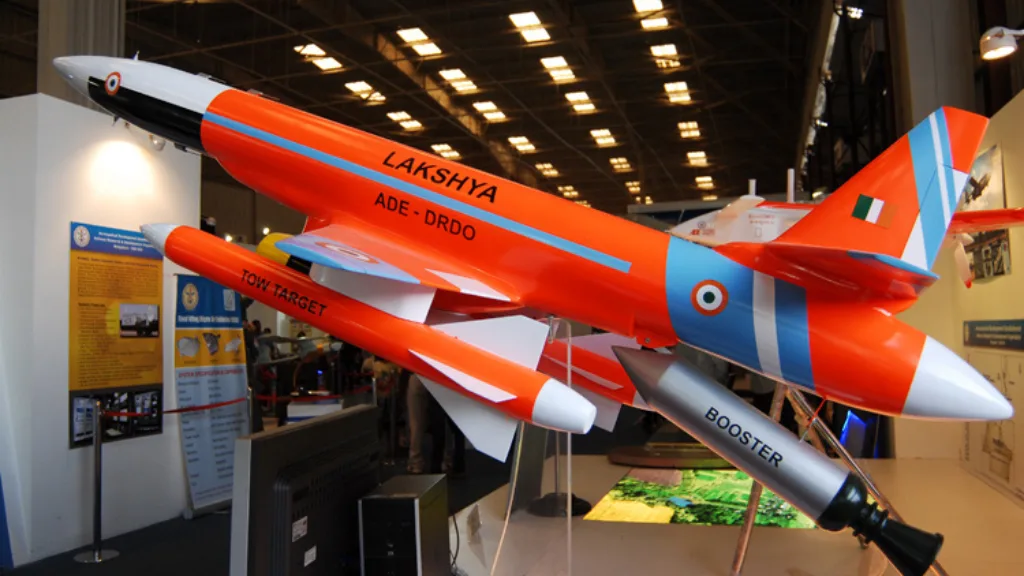Introduction
The Lakshya drone system, developed by India’s Defence Research and Development Organisation (DRDO), is a significant advancement in unmanned aerial vehicle (UAV) technology.
It plays a crucial role as a pilotless target aircraft (PTA), offering a versatile solution for both training and reconnaissance purposes for the Indian Armed Forces.
By examining its background, development, features, and operational capabilities, we gain a deeper understanding of its vital role in modern military strategy.
Background and Development
Origins of the Lakshya Project
The need for a pilotless target system was first recognized in 1976. This led to a series of comprehensive feasibility studies carried out by the Aeronautical Development Establishment (ADE).
After years of research, the project gained approval in 1980, with an investment of ₹170 million. The goal was to create a standardized system that would serve the operational requirements of the Indian Army, Navy, and Air Force.
Engine Development
Alongside the drone design, the indigenous PTAE-7 turbojet engine was developed by Hindustan Aeronautics Limited (HAL). This engine, which generates 3.73 kN of thrust, was pivotal in ensuring the drone’s performance.
The first successful flight trials of the Lakshya UAV prototypes took place between 1985 and 1986, confirming the design’s viability. While there were challenges in the initial stages, these trials proved the potential of the Lakshya system.
Advancements Over Time
The Lakshya system has undergone multiple upgrades since its official induction on November 9, 2000. One of the most notable improvements was the introduction of the Lakshya-2 variant.
This version, capable of flying at low altitudes, can simulate the flight patterns of low-level cruise missiles.
This enhancement has made the Lakshya drone an indispensable tool for real-world combat simulations and training exercises, enabling military forces to practice countermeasures against missile threats.
Key Features
Design and Functionality
The Lakshya drone incorporates several advanced design features that maximize its operational effectiveness in diverse military settings:
- Launch Mechanism: The drone can be launched from both ground and sea platforms using a zero-length launcher. This flexibility allows for deployment in various environments, enhancing its versatility.
- Recovery System: A two-stage parachute recovery system is employed to ensure the drone is safely retrieved after each mission. This feature helps to extend the drone’s lifespan and reduces operational costs by enabling multiple uses.
- Durability: The drone is designed with a crushable nose cone that minimizes damage upon landing. This ensures that the system can be reused for several missions, making it a cost-effective solution.
Ground Control and Navigation
The Lakshya drone is remotely controlled from a ground control station. Operators can input pre-programmed flight paths or issue real-time commands for dynamic adjustments during missions.
This flexibility allows the drone to perform a wide range of tasks, from reconnaissance to live-fire training exercises, making it a valuable asset in military operations.
Specifications
The Lakshya drone boasts impressive specifications that make it a reliable asset for both training and reconnaissance purposes. These include:
- Length: 2.385 meters
- Wingspan: 5 meters
- Maximum Speed: Mach 0.7
- Range: 150 km
- Service Ceiling: 9,000 meters
These specifications make the Lakshya UAV a versatile platform for simulating aerial targets, testing missile systems, and providing critical training for military personnel.
Operational History
Deployment and Use
Since its official induction, Lakshya drones have been integrated into the operational fleets of the Indian Air Force and Navy. Over 23 units have been deployed, significantly enhancing the training capabilities of missile and gunner crews.
The drone’s ability to simulate real-world targets has enabled Indian forces to refine their skills and improve target accuracy during exercises.
International Interest
The Lakshya drone has attracted global attention, with countries such as Singapore and Israel expressing interest in demonstrations of its capabilities.
The growing international interest in the drone underscores its effectiveness and highlights its potential as an exportable product. This also reflects the technological prowess of the DRDO and India’s growing role in the global defence market.
Continued Evolution
As military technologies evolve, so does the Lakshya system. Future versions of the drone are expected to include enhanced reconnaissance capabilities, with improved onboard sensors and autonomous operation features.
These advancements will ensure that Lakshya remains at the cutting edge of UAV technology, continuing to serve both domestic and international clients effectively.
Conclusion
The Lakshya unmanned aerial vehicle (UAV) represents a fusion of advanced engineering and strategic military planning. Its evolution, from an initial response to the need for target training to a versatile multi-role drone system, has transformed how the Indian Armed Forces approach aerial training and reconnaissance.
The continuous advancements in its design and functionality ensure that the Lakshya system will remain a crucial asset in modern defence strategies. As global defence demands evolve, the Lakshya drone will continue to play a pivotal role, offering unparalleled support for military training and operations.
Learn more at DefenceNewsIndia.in – your trusted source for updates on India’s defense, aerospace, and strategic innovations.
